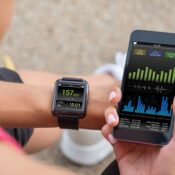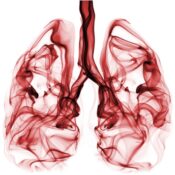Click here for Part 1: Understanding SCA. 5 facts about sudden cardiac arrest and heart attack.
Preventing Sudden Cardiac Arrest
Every two minutes, someone collapses and dies from a malfunction in the heart’s electrical system—a condition called sudden cardiac arrest or SCA—and most of the victims have no idea they are at risk for the tragic event.
“That’s absolutely true,” says Dr. Richard Page, immediate past president of the Heart Rhythm Society and chair of the Department of Medicine at the University of Wisconsin School of Medicine and Public Health. “While a single individual’s chance of dying suddenly is quite small, there are so many people out on the street with some risk that the overwhelming majority of SCA victims have not ever demonstrated cardiac disease.”
The challenge for SCA researchers is two-fold, according to Dr. Page, who recently took time to discuss with us the latest findings on SCA risk factors and symptoms, as well as advances in preventing the heart emergency and saving lives.
“It comes down to two questions,” explains the heart rhythm specialist. “How can we better identify those at risk? And, given the fact we can’t identify all (or even most) of the potential patients: How do we address sudden cardiac arrest when it does happen?
Post: About 250,000 Americans die of sudden cardiac arrest every year. Who is at most at risk?
Dr. Page: Ongoing research confirms that heart structure is an important risk factor. People with an enlarged heart, or heart damage from a prior heart attack, are at higher risk for SCA than those with normal heart structure.
Remember, a heart attack isn’t a sudden cardiac arrest; a heart attack is death of heart tissue due to a blockage in an artery. A person who has a heart attack doesn’t lose consciousness, unless they have a cardiac arrest on top of that.
But it is clear from large, multi-center, randomized studies that many patients with prior injury to the heart or enlargement of the heart are better off with an implanted cardioverter defibrillator (ICD) than without one.
More recently, we have identified certain families who are at higher risk because of cardiomyopathy (a condition in which the heart is enlarged or thickened) or an electrical abnormality called long Q-T syndrome that can be seen on the EKG test. In addition, investigators are identifying the genetic abnormalities that underlie these conditions, as well as some genetic traits that may put one at higher risk of sudden cardiac arrest that are less subtle than abnormal heart structure or function.
Post: Is genetic screening for SCA risk available yet?
Dr. Page: Genetic tests for the general population are not ready for primetime because the genes don’t predict risk adequately. An abnormal EKG, for example, may or may not represent a significant risk to the individual. But we may have genetic tests for general screening five or ten years from now.
Likewise, there continues to be some debate as to the proper way to screen athletes. In Europe (particularly in Italy) everyone who participates in sports is screened with an electrocardiogram. The American Heart Association doesn’t yet recommend that. But they do advise that people be examined and asked about personal and family history. If someone has family members who died suddenly, he or she is clearly at higher risk for SCA and should be evaluated further.
Post: You mentioned that Italy recommends EKGs. Don’t we use echocardiograms (Echos) to screen U.S. athletes?
Dr. Page: We do both in some cases—but according to the risk. The most aggressive method of screening athletes is an exam, a history, an EKG, and an Echo. The echocardiogram defines heart structure. It provides a two-dimensional moving picture that shows chamber size and wall thickness. An EKG provides indirect evidence of structure. For example, alterations in electrical activity may suggest hypertrophy, or a prior heart attack. It doesn’t necessarily tell you if the heart is enlarged or damaged the way an Echo does, but it’s a simple and less expensive test.
Another point about universal screening: Some might say, “Well, let’s just screen everybody.” Well, the problem is that the tests aren’t perfect. If you screen a low-risk population, there will be some false positive results. I am concerned that the Italian protocols have excluded too many athletes. So universal screening of athletes might cause undue concern, and even cause some athletes at low risk to stop competing. Universal screening of low-risk individuals is a double-edged sword.
Are there any symptoms or warning signs of SCA?
Dr. Page: There may be symptoms in some cases. An important warning is passing out, or fainting. Most episodes of passing out are not a cause for alarm. But people should get checked out if they pass out while exercising, or if they experience palpitations and feel close to passing out. In addition, those with a history of heart attack or heart failure need to know their ejection fraction—a number that reflects the percentage of blood that is pumped from the left ventricle with each heartbeat. A good, efficient heartbeat pumps out more than half the blood in that chamber. When the heart is enlarged or scarred, however, the ejection fraction can drop below 35 percent or less. These people are at higher risk of SCA, and may be candidates for an ICD. A patient ought to be able to ask a doctor, “Is my heart enlarged, and if so, is there a number that would suggest I should have a defibrillator implanted?”
Post: What type of test is used to determine the patient’s ejection fraction?
Dr. Page: The most common test used to determine the ejection fraction is the echocardiogram. As I mentioned earlier, this test is basically a two-dimensional movie. Geometric calculations of the chamber volume just before and after the left ventricle squeezes suggest how much blood is pumped from the heart. For example, if the volume was a hundred before it squeezes and 50 after it squeezes, that’s an ejection fraction of 50 percent, which is good. But if the volume was 100 squeezing down to 75, that’s an ejection fraction of 25 percent, which is bad, and adds risk for sudden cardiac arrest.
Post: What should people do to lower their risk of SCA?
Dr. Page: If you have a personal or family history of recurrent pass-out spells, see a doctor. But all of us (whether or not we have heart disease) should care of our hearts. Discuss your cardiovascular risk factors with your doctor. Then, stop smoking, eat properly, exercise, control diabetes, and keep blood pressure and cholesterol in check to protect your heart and blood vessels.
Minimizing the risk of developing heart disease lowers the risk of heart damage and sudden cardiac arrest. Every day, I tell patients they ought to exercise. I don’t want to be a hypocrite, so I work out between 4:30 and 5:30 each morning, and then go to the office. I wish I ate a perfect diet, but I am trying!
Watch for more from Dr. Page about saving lives with automated external defibrillators (AEDs) in a future Medical Update posting.
Become a Saturday Evening Post member and enjoy unlimited access. Subscribe now




Comments
Master`s Swimming is becoming very competitive. The heart can not pump at the same rate at 4O ` 5O` 60. A few champions have been lost this way in sprints. It would pay to stick to long events. Martin.
Sudden death is common and unenlightening; sudden life is rare and intensely gratifying.